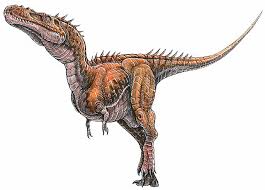 Alioramus is a typical tyrannosaurid from Late Cretaceous of Asia. He was described by Sergei Kurzanov in 1976. Some scientist believe that Alioramus is a juvenile of Tarbosaurus.But the latest discovery of Alioramus made it clear that last hypothesis was incorrect. His maximal size isn't known because Alioramus is known from juvenile or sub-adult fossils. Alioramus had greater number of teeth than any other tyrannosaur.
Alioramus is a typical tyrannosaurid from Late Cretaceous of Asia. He was described by Sergei Kurzanov in 1976. Some scientist believe that Alioramus is a juvenile of Tarbosaurus.But the latest discovery of Alioramus made it clear that last hypothesis was incorrect. His maximal size isn't known because Alioramus is known from juvenile or sub-adult fossils. Alioramus had greater number of teeth than any other tyrannosaur.
Alioramus wasn't big, aproaching 6 meters in length, but scientists believe that it is juvenile size of Alioramus. The skull of Alioramus is 45 centimetres long.
 The Maastrichtian stage in Mongolia, as preserved in the Nemegt Formation and at Nogon-Tsav, was characterized by a wetter and more humid climate compared with the semi-arid environment preserved in the earlier, underlying Barun Goyot and Djadochta Formations. Nemegt sediments preserve floodplains, large river channels and soil deposits, but caliche deposits indicate periodic droughts. This environment supported a more diverse and generally larger dinosaur fauna than in earlier times. Kurzanov reported that other theropods, including Tarbosaurus, ornithomimosaurs and therizinosaurs were discovered at the same locality,but these remains have never been reported in detail. If the Nogon Tsav fauna was similar to that of the Nemegt Formation, troodontid theropods, as well as pachycephalosaurs, ankylosaurids and hadrosaurs would also have been present. Titanosaurian sauropods were also potential prey for predators in the Nemegt.
The Maastrichtian stage in Mongolia, as preserved in the Nemegt Formation and at Nogon-Tsav, was characterized by a wetter and more humid climate compared with the semi-arid environment preserved in the earlier, underlying Barun Goyot and Djadochta Formations. Nemegt sediments preserve floodplains, large river channels and soil deposits, but caliche deposits indicate periodic droughts. This environment supported a more diverse and generally larger dinosaur fauna than in earlier times. Kurzanov reported that other theropods, including Tarbosaurus, ornithomimosaurs and therizinosaurs were discovered at the same locality,but these remains have never been reported in detail. If the Nogon Tsav fauna was similar to that of the Nemegt Formation, troodontid theropods, as well as pachycephalosaurs, ankylosaurids and hadrosaurs would also have been present. Titanosaurian sauropods were also potential prey for predators in the Nemegt.

No comments:
Post a Comment